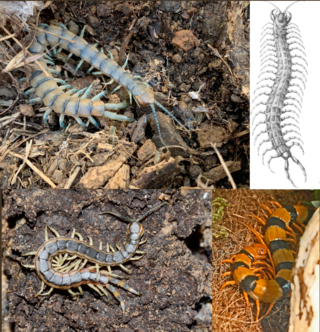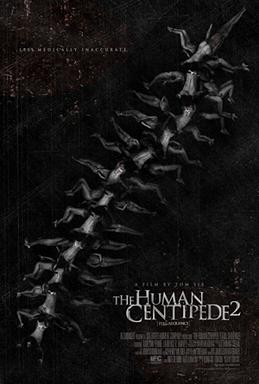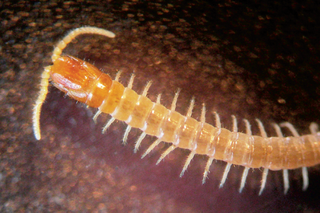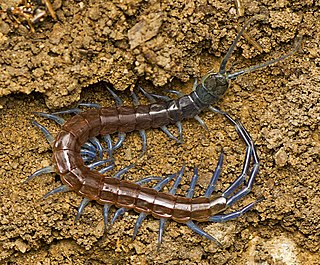Related Research Articles

Centipedes are predatory arthropods belonging to the class Chilopoda of the subphylum Myriapoda, an arthropod group which includes millipedes and other multi-legged animals. Centipedes are elongated segmented (metameric) creatures with one pair of legs per body segment. All centipedes are venomous and can inflict painful stings, injecting their venom through pincer-like appendages known as forcipules or toxicognaths, which are actually modified legs instead of fangs. Despite the name, no centipede has exactly 100 pairs of legs; number of legs ranges from 15 pairs to 191 pairs, always an odd number.

Scolopendra heros, commonly known as the Arizona desert centipede, giant desert centipede, giant Sonoran centipede, Texas black-tailed centipede, Texas redheaded centipede, and giant redheaded centipede, is a species of North American centipede found in the Southwestern United States and Northern Mexico.

Scolopendra gigantea, also known as the Peruvian giant yellow-leg centipede or Amazonian giant centipede, is a centipede in the genus Scolopendra. It is the largest centipede species in the world, with a length exceeding 30 centimetres (12 in). Specimens may have 21 or 23 segments. It is found in various places throughout South America and the extreme south Caribbean, where it preys on a wide variety of animals, including other sizable arthropods, amphibians, mammals and reptiles.

Scolopendra subspinipes is a species of very large centipede found throughout southeastern Asia. One of the most widespread and common species in the genus Scolopendra, it is also found on virtually all land areas around and within the Indian Ocean, all of tropical and subtropical Asia from Russia to the islands of Malaysia and Indonesia, Australia, South and Central America, the Caribbean islands, and possibly parts of the southern United States, but how much of this range is natural and how much due to human introduction is unclear. With a wide geographic range and numerous color variations, the species is known by many common names, including jungle centipede, orange-legged centipede, Hawaiian centipede, and Vietnamese centipede.

Ethmostigmus rubripes, commonly known as the giant centipede, is a species of centipede in the family Scolopendridae. It is a solitary nocturnal predator found across Asia and Oceania, with three subspecies currently described.

Scolopendridae is a family of large centipedes.

Scolopendra is a species-rich genus of large tropical centipedes of the family Scolopendridae.

The Scolopendromorpha, also known as tropical centipedes and bark centipedes, are an order of centipedes whose members are epimorphic and usually possess 21 or 23 trunk segments with the same number of paired legs. The number of leg pairs is fixed at 21 for most species in this order and fixed at 23 for the remaining species, except for two species with intraspecific variation: Scolopendropsis bahiensis, which has 21 or 23 leg pairs, and Scolopendropsis duplicata, which has 39 or 43 leg pairs. Species in this order have antennae with 17 or more segments. The order comprises the five families Cryptopidae, Scolopendridae, Mimopidae, Scolopocryptopidae, and Plutoniumidae. Nearly all species in the family Scolopendridae have four ocelli on each side of the head, and the genus Mimops features a pale area often considered an ocellus on each side of the head, whereas the other three families are blind. Species in the family Scolopocryptopidae have 23 leg-bearing segments, whereas species in all other families in this order have only 21 leg-bearing segments. The only 3 known amphibious centipedes, Scolopendra cataracta, Scolopendra paradoxa and Scolopendra alcyona belong to this order.

The Craterostigmomorpha are the least diverse centipede clade, comprising only two extant species, both in the genus Craterostigmus. Their geographic range is restricted to Tasmania and New Zealand. There is a single ocellus on each side of the head capsule. They have a distinct body plan; their anamorphosis comprises a single stage: in their first moult, they grow from having 12 trunk segments to having 15. Adult centipedes in this order, like those in Scutigeromorpha and Lithobiomorpha, have 15 leg-bearing segments. Their low diversity and intermediate position between the primitive anamorphic centipedes and the derived Epimorpha has led to them being likened to the platypus. They represent the survivors of a once diverse clade. Maternal brooding unites the Craterostigmomorpha with the Epimorpha into the clade Phylactometria which includes Craterostigmomorpha, Scolopendromorpha and Geophilomorpha. This trait is thought to be closely linked with the presence of sternal pores, which secrete sticky or noxious secretions, which mainly serve to repel predators and parasites. The presence of these pores on the Devonian Devonobius which is included in own order Devonobiomorpha permits its inclusion in this clade, allowing its divergence of Lithobiomorpha from Phylactometria to be dated to 375 million years ago.

The Human Centipede (First Sequence) is a 2009 Dutch independent body horror film written, directed and co-produced by Tom Six. The film concerns a deranged German surgeon who kidnaps three tourists and conjoins them surgically, mouth to anus, forming the eponymous "human centipede". It stars Dieter Laser as Josef Heiter, the creator of the centipede; and Ashley C. Williams, Ashlynn Yennie, and Akihiro Kitamura as Heiter's victims.

The Human Centipede 2 (Full Sequence) is a 2011 psychological body horror film written, directed, and co-produced by Tom Six. An international co-production of the Netherlands and the United Kingdom, and the sequel to Six's 2009 film The Human Centipede (First Sequence), the film stars Laurence R. Harvey as a psychiatrically and intellectually impaired English man who watches and becomes obsessed with the first Human Centipede film, and decides to make his own "centipede" consisting of 12 people, including Ashlynn Yennie, an actress from the first film.
Mazoscolopendra is an extinct genus of scolopendromorph centipedes, and the oldest known member of that order. It existed during the Carboniferous in what is now Illinois.

Grasshopper mice are rodents of the genus Onychomys, occurring in North America. They feed on insects and other arthropods.

Scolopocryptopidae is a family of blind centipedes. The number of leg-bearing segments is fixed at 23 for species in this family, which distinguishes the species in this family from all other centipede species.

The Cryptopidae are a family of scolopendromorph centipedes. Cryptopids are blind and possess 21 pairs of legs. The genus Cryptops is the numerically largest in the family, comprising over 150 species worldwide.

Mecistocephalidae is a monophyletic family of centipedes in the order Geophilomorpha. It is the only family in the suborder Placodesmata. Most species in this family live in tropical or subtropical regions, but some occur in temperate regions. This family is the third most diverse in the order Geophiliomorpha, with about 170 species, including about 130 species in the genus Mecistocephalus.
Cormocephalus westwoodi is a species of centipedes in the family Scolopendridae. The species was previously considered by many names in many regions of the world, where some synonyms are still exists valid in certain countries. Five subspecies are currently recognized.

Plutoniumidae is a family of centipedes belonging to the order Scolopendromorpha. Centipedes in this family are blind and have 21 pairs of legs.

Scolopocryptops sexspinosus, the eastern red centipede, is a species of centipede in the family Scolopocryptopidae. It is found in North America. It is the only scolopendromorph definitively found in Canada. Canadian specimens appear to be most abundant in British Columbia and Vancouver Island. It is widespread across eastern North America from far southern Canada to the Carolinas and the Gulf Coast, and prefers hiding under rotting wood or leaf litter ; it is thus difficult to find.

Rhysida is a large genus of Scolopendromorph centipedes in the subfamily Otostigminae. It is the second largest genus in the subfamily Otostigminae, with species found in the Neotropics, Indo-Malaya, and Africa. It shares some morphological characteristics with the genus Alluropus, and its phylogeny in the subfamily Otostigminae is somewhat uncertain.
References
- 1 2 Khramov, Alexander; Shear, William; Mercurio, Randy; Kopylov, Dmitry (2018). "The first Permian centipedes from Russia". Acta Palaeontologica Polonica. 63. doi:10.4202/app.00482.2018. ISSN 0567-7920.